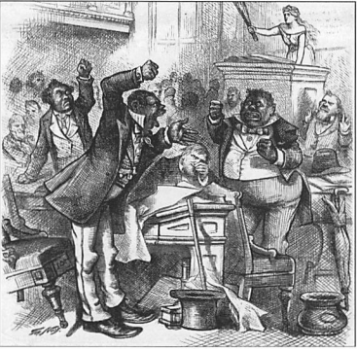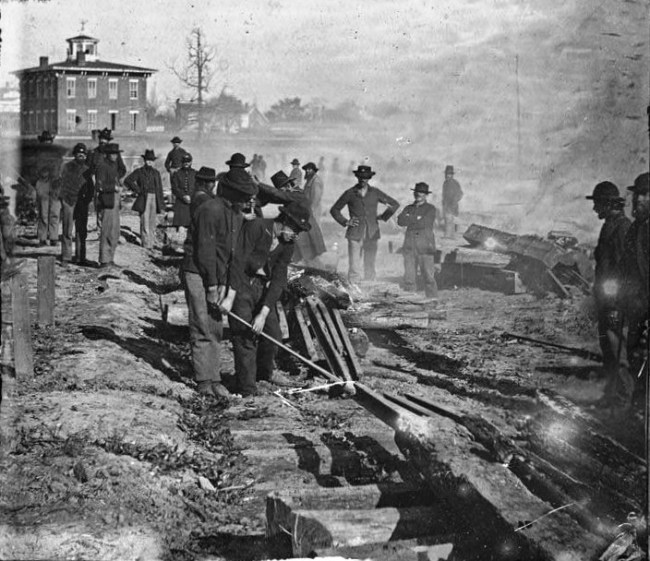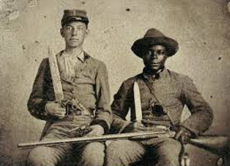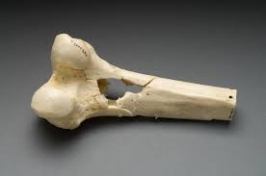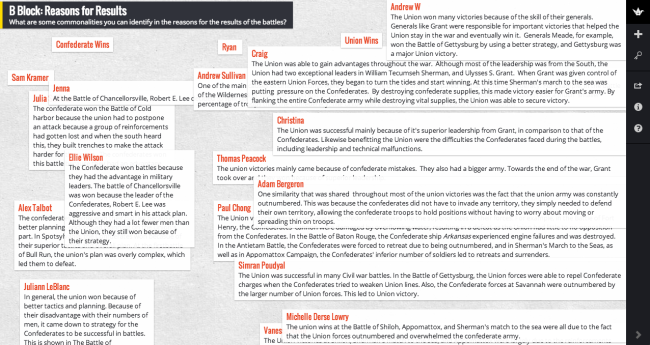Once I had finished reading the textbook information and required reading on Imperialism in America, it was next time to dig deeper and analyze some primary sources on the topic. I used a webquest about the Spanish American War (http://historicalthinkingmatters.org/spanishamericanwar/). This website had an assortment of primary sources regarding the war, and included questions and sourcing help to give further understanding to the documents. Along with this webquest, the website gave two additional webquests that gave multiple websites full of primary sources about Imperialism and America. Using this new information gained from the primary sources, I was able to add more key terms, as well as a whole new Enduring Understanding. It also gave me a chance to cut of key words and phrases that might have seemed important at the beginning, but as I went along they did not seem to fit anymore. Finally, I found new details to support my first three Enduring Understandings.
Key Terms/Phrases
Imperialism: When stronger nations attempt to create empires by dominating weaker nations- economically, politically, culturally, or militarily
Nationalism: devotion to one’s nation
Annex: to join a new territory to an existing country
Monroe Doctrine: Document that declared the United States neutral in European Wars. It also warned other nations not to interfere in the Western Hemisphere.
Manifest Destiny: American settlers thought they were destined to expand throughout the continent.
Captain Alfred T. Mahan: argued America’s economic future hinged on gaining new markets abroad. The US needed a powerful navy to protect these markets from foreign rivals.
Naval Act of 1889: called for the construction of more naval artillery- made the United State’s navy one of the most powerful in the world.
Theodore Roosevelt: President of the United States from 1901-1909. Thought imperialism would increase the American spirit.
Jingoism: burst of American pride and the desire for an aggressive foreign policy.
Platt Amendment: stated they America would remove troops from Cuba only if Cuba would not enter any foreign agreements and allow the US to form naval bases and intervene whenever necessary.
Teller Amendment: Promised that that the United States wouldn’t annex Cuba.
Sphere of influence: an area of economic or military control
The Cuban Rebellion: rebelled against Spain, but then the US came in and took over led to the Treaty of Paris.
The Treaty of Paris: Gave the US the Philippines, Puerto Rico, and Guam. They became “unincorporated” territories of the US, which meant they weren’t intended for eventual statehood.
Surplus products: products that the citizens of America were not able to use, and needed to be traded to other markets
American Anti-imperialist League: organized in opposition to the annexation of the Philippine Islands
1. Countries who wanted to gain power globally would do it by gaining control of people and places outside of their territory.
- The Spanish-American War led to America taking Cuba away from Spain. Cuba gained independence from Spain, but because The US won the war they got control over Cuba: “Many Cubans felt that the United States had betrayed its goal of securing independence from Cuba. To some, it seemed that the United States had simply replaced Spain as Cuba’s sovereign nation” (America textbook, 594).
- America annexed Hawaii because they needed it for naval reasons: “After briefly considering whether the Hawaiian people wished to be annexed, Congress was swayed by arguments that the United States needed naval stations in Hawaii in order to protect its world trade” (America textbook, 595).
- America took over the Philippines in order to increase their power positioning in the Pacific.
“June-October 1898
U.S. business and government circles united around a policy of retaining all or part of the Philippines.
June 3
President McKinley broadened U.S. position to include an island in the Marianas, as a strategic link in the route from the United States to the Pacific Coast of Asia” (Chronology for the Philippine Islands and Guam in the Spanish-American War).
2. In a country’s decision to gain power over other countries, the citizens of the country trying to take over debate the validity of taking over places and people of the other countries.
- Some thought it was a good idea, because it would help the economy of America: “The profit system, with it natural tendency for expansionism, had already begun to look overseas. The severe depression that began in 1893 strengthened an idea developing within the political and financial elite of the country” (The Empire of the People, 297).
- “In Cuba, alone, there are 15,000,000 acres of forest unacquainted with the axe. There are exhaustless mines of iron…. There are millions of acres yet unexplored….
It means new employment and better wages for every laboring man in the Union….” (Excerpt from Albert J. Beveridge’s Senate campaign speech, September 16, 1898.)
- People also thought it was a good idea because it would unite the country: “And would not a foreign adventure deflect some of the rebellious energy that went into strikes and protest movements towards an external enemy? Would it not unit people with government, with the armed forces, instead of against them?” (The Empire of the People, 297).
Dost hear the sailors scream?
Comrades will you go?
Avenge the cruel blow!”
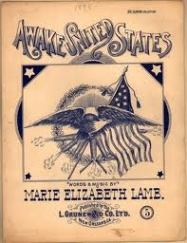
(Marie Elizabeth Lamb, Awake United States! (New Orleans, LA: 1898).)
- Some did not support the idea of America taking over other countries (like Cuba), because they thought that it was unnecessary and would ruin the Cuban’s way of life: “’We assume that what we like and practice, and what we think better, must come as a welcome blessing to Spanish-Americans and Filipinos. This is grossly and obviously untrue. They hate our ways. They are hostile to our ideas. Our religion, language, institutions, and manners offend them’ –William G. Sumner, Yale University professor, in a 1898 speech” (America textbook, 605).
3. People used the power of the press to influence the idea of taking over places outside of ones country.
- Journalists covering the Spanish-American war hyperbolized war stories about Cuban rebels to get American’s support for the US to intervene: “Their sensational headlines and stories, known as yellow journalism, whipped up American public opinion in favor of the rebels.” (America textbook, 591).
- Socialist newspapers warned that the hype created from the sinking of the Maine was really for America to advance their power: “A gigantic…and cunningly-devised scheme is being worked ostensibly to place the United States in the front rank as a naval and military power. The real reason is that the capitalists will have the whole thing and, when any workingmen dare to ask for the living wage… they will be shot down like dogs in the street” (The Craftsman, The Empire of the People, 307).
- Cartoons were made to show that America was welcoming in Cuba to their country, and saving them from the bondage of Spain.
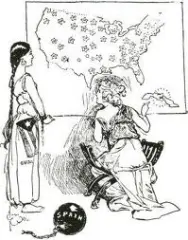 (Miss Cuba Receives an Invitation, Chicago Record-Herald, 1901. Chicago, Illinois.)
(Miss Cuba Receives an Invitation, Chicago Record-Herald, 1901. Chicago, Illinois.)
- Some could view this account as a way to get Americans to push for involvement in Cuba: “Four hundred and sixty women and children thrown on the ground, heaped pell-mell as animals, some in a dying condition, others sick and others dead, without the slightest cleanliness, nor the least help….” ( Excerpt from an unsigned enclosure included with a telegram sent by Fitzhugh Lee, U.S. Consul-General in Cuba, November 27, 1897. Havana, Cuba.)
4. To validate taking over other people and places, countries would say that if they did not the safety and power of themselves would be put at risk.
- While declaring war on Spain, President McKinley said that one of the main reasons why he did was because Americans were in danger
“With such a conflict waged for years in an island so near us and with which our people have such trade and business relations; when the lives and liberty of our citizens are in constant danger and their property destroyed and themselves ruined; where our trading vessels are liable to seizure and are seized at our very door by warships of a foreign nation,”
- “Such proceedings would seem to be in line with that prudence and foresight necessary to afford safety to the Americans residing on the island, and to their properties, both of which, I have every reason to know, are objects of the greatest concern to our Government” (Excerpt from telegram sent by Fitzhugh Lee, U.S. Consul-General in Cuba, December 3, 1897. Havana, Cuba).
To reflect on the new information I have, it was assigned to look at our topic (in my case, Imperialism in America) as someone who is at the bottom of the power struggle. Looking at Imperialism in America, I believe a citizen of Cuba would be at the bottom of the power ladder, because they do not have much say in anything. Not having a say in who ruled them, Cubans were constantly being thrown back and forth. First, they were ruled by Spain, who tried to force their beliefs upon them. They were forced to relocate and live in areas created by the Spanish government, and people were treated very poorly in these areas (Reconcentration Camps, from webquest). When America came to fight against Spain, there was a glimmer of hope because the Filipinos thought the Americans would help them gain independence. But this was not the case, and it seemed that America just took over Spain’s job. The pushed their beliefs and culture onto the Cubans, not caring about how they would react to this new way of life. William G. Sumner reflected on this idea, saying “We assume that what we like and practice, and what we think better, must come as a welcome blessing to Spanish-Americans and Filipinos. This is grossly and obviously untrue. They hate our ways. They are hostile to our ideas. Our religion, language, institutions, and manners offend them” (America textbook, 605). Imperialism affected citizens of Cuba negatively because they did not have the ability to rule themselves and live freely.




